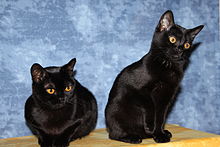Bombay cat
| Bombay | |
|---|---|
 A common Bombay cat | |
| Common nicknames | Parlor Panther |
| Origin | United States |
| Breed standards | |
| CFA | standard |
| TICA | standard |
| ACF | standard |
| ACFA/CAA | standard |
| CCA-AFC | standard |
| Domestic cat (Felis catus) | |
The Bombay cat is a short-haired breed of domestic cat. Bombays are glossy solid black cats with a muscular build, and have characteristic large bright copper-golden eyes.[1][2][3] The breed is named after the Indian city of Bombay (Mumbai),[4] referring to the habitat of the Indian black leopard.[5]
There exist two different variants of Bombay breed; the American Bombay and the British Bombay. American-type Bombays were developed by
Both type of Bombay cats are
History
The breed was developed by Nikki Horner, a breeder from Louisville, Kentucky, who, starting in 1958, attempted to create a breed of cat that resembled a miniature black panther.[4][5][10] The first attempt was a failure, but the second, in 1965, was successful. The breed was officially recognised and registered by the Cat Fanciers' Association in 1970 and The International Cat Association in 1979.[4][10]
Appearance

The Bombay is described as the “patent leather kid with the new penny eyes.”[2][5] The Bombay is a short-haired breed of domestic cat, closely related to the Burmese. Bombay cats are characterised as having an all-black coat, including the whiskers, and black skin, including the soles, nose leather and mouth. The close-lying, sleek and glossy black coat is of mature cats is coloured to the roots with no paling (exceptions are allowed in juvenile cats less than 2 years old).[4] The eyes are always copper-golden coloured,[1][2] and green eyes are not allowed.[2][3]

The Bombay has a medium-sized, Oriental-type body build that is muscular.[1][4] Their weight ranges between 2.5–5 kg (5.5–11.0 lb),[1] with males typically being heavier than females.[3][11]
Breed standard
Body: Medium size, graceful and elongated Oriental-type body.[1] Elegant tail of medium length.[3]

Head: Rounded heads with no sharp angles, and short.[3] The shape is smooth. The muzzle is short, with a moderate nose “stop” which is visible (not a break).[2][3] The short-nosed head shape is similar to the American-type Burmese. The medium-sized ears are wide-set, straight, and rounded at the tips.
Eyes: The large, round eyes are set far apart[3] and are always copper-coloured,[2] but can range from bright orange to warm golden.[3] Green eyes are not allowed.[2][3]
Coat: Short, dense and shiny, tight to the body, with a lacquered sheen.[12] Only completely solid black coloured coats are allowed.[2][3]
Weight: For females, the average is 2.5–3.5 kg (6–8 lb). For males, the average is 3.5–5 kg (8–11 lb).[1][6]
Health
A healthy Bombay has an average lifespan of 15 years, and some have been known to live up to 20.[11] They can have some nasal and sinus problems, and gingivitis.[13] Their food intake should be controlled to avoid overfeeding.[13]
Temperament
The personality of the Bombay tends to be highly social, is marked by strong attachment to families, and is typified by craving attention. As a breed, they are therefore highly suitable for children.[14]
Bombay cats are happy and comfortable being strictly indoor cats, and can comfortably live in a single room apartment, so long as all of their needs are met.[15] They prefer quiet surroundings.[15]
References
- ^ OCLC 1322361804.
- ^ a b c d e f g h "Bombay TICA breed standard" (PDF). Archived from the original (PDF) on 29 September 2023. Retrieved 29 September 2023.
- ^ a b c d e f g h i j "Bombay CFA breed standard" (PDF). CFA.org. Cat Fanciers' Association. 2019. Archived (PDF) from the original on 29 September 2023. Retrieved 29 September 2023.
- ^ a b c d e "Bombay". TICA.org. The International Cat Association (TICA). 13 August 2018. Archived from the original on 29 September 2023. Retrieved 29 September 2023.
- ^ a b c d "Bombay". CFA.org. Cat Fanciers' Association. Retrieved 29 September 2023.
- ^ Dorling Kindersley Limited: 2008
- ^ "Bombay and Asian Cats Breed Club". www.bombayandasiancatsbreedclub.org. Retrieved 29 September 2023.
- The Cat Fanciers' Association. Retrieved 25 March 2024.
- ^ "What are Papers and Do I Need Them For My Pedigree Kitten?". Registered Pets. Retrieved 25 March 2024.
- ^ a b "History". Rokstarr Bombay. Retrieved 24 February 2016.
- ^ a b "Bombay Cat Breed Profile". pet-adoption-guide.com. Archived from the original on 16 February 2013. Retrieved 12 January 2013.
- ^ "How does Bombay look like?". bombaykittens.com. Retrieved 16 February 2023.
- ^ a b "Cat Breeds – The Bombay Cat – Cats, Chaos and Confusion". cats-chaos-and-confusion.com. Retrieved 4 January 2017.[permanent dead link]
- ^ "Bombay Cat". Petfinder. Retrieved 12 June 2011.
- ^ ISBN 978-1-57215-086-7. Retrieved 5 April 2023.
External links
![]() Media related to Bombay cats at Wikimedia Commons
Media related to Bombay cats at Wikimedia Commons
